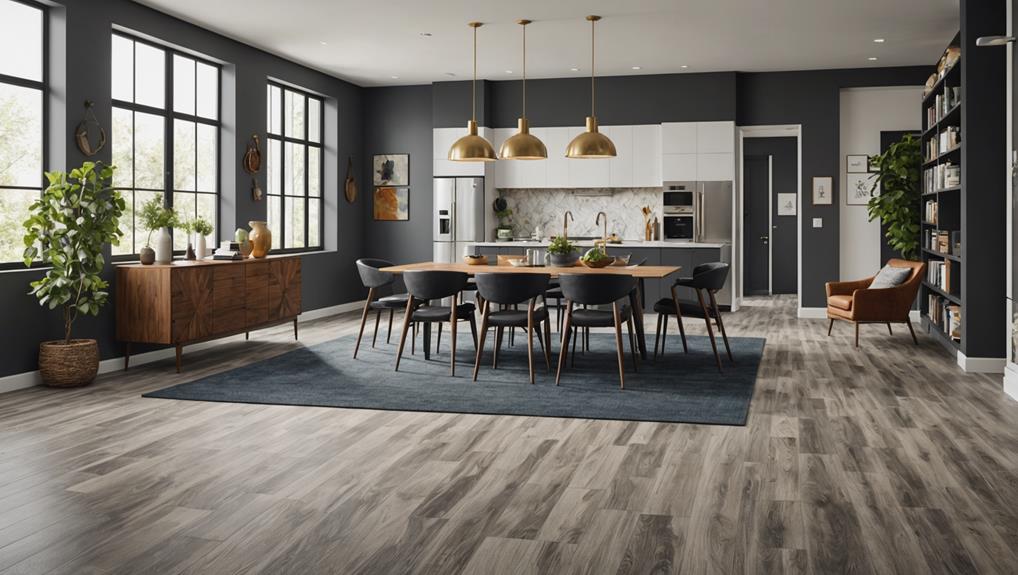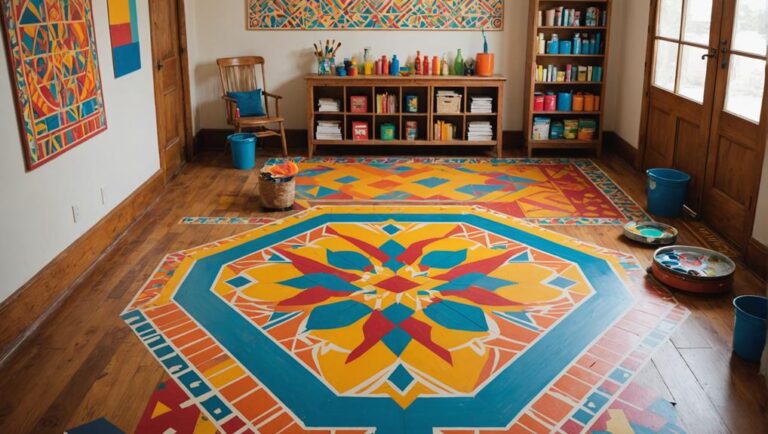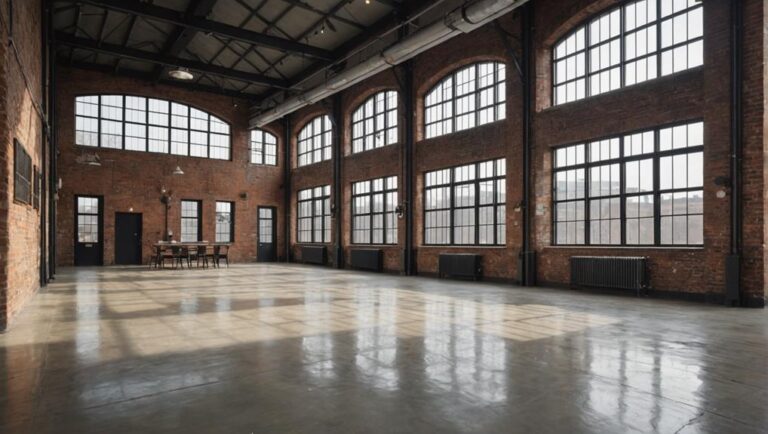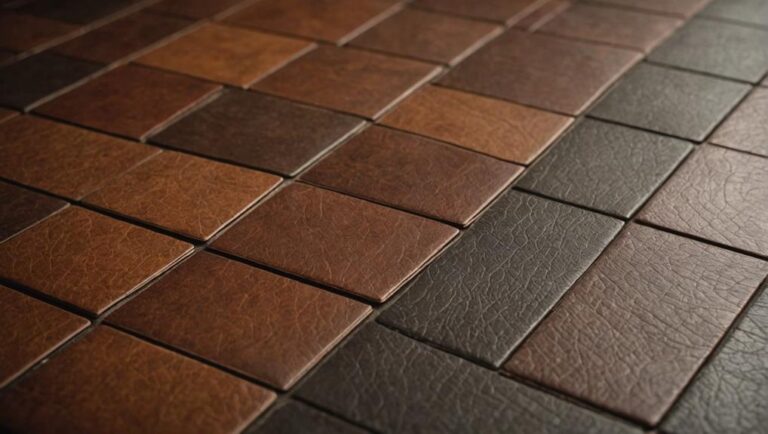When you're choosing resilient flooring for high-traffic areas, opt for materials like vinyl, rubber, or linoleum for their durability and impact absorption. Look for features such as scratch and moisture resistance to maintain appearance and prevent damage. Vinyl plank flooring is a popular choice due to its waterproof nature and easy maintenance. Additionally, consider slip-resistant surfaces to enhance safety in busy spaces. It's important to assess durability ratings and installation methods to guarantee longevity. Understanding these aspects will help you create a functional and appealing environment that stands up to daily use, with more insights just ahead.
Understanding Resilient Flooring
Understanding resilient flooring involves recognizing its unique characteristics and advantages. Resilient flooring is crafted from resilient materials such as vinyl, linoleum, and rubber, designed to absorb impact and provide comfort underfoot. These materials are engineered to withstand the rigors of high-traffic areas, making them ideal for both residential and commercial spaces.
You'll find that modern flooring innovations have led to significant advancements in the durability and aesthetic appeal of resilient flooring. For instance, many products now feature enhanced surface treatments that resist scratches, stains, and wear, contributing to a safer environment. This is particularly vital in settings where slips and falls are a concern, as the textured surfaces available in resilient flooring can provide additional traction.
Moreover, resilient flooring is often designed to be easier to clean and maintain compared to traditional flooring options. Its water-resistant properties help mitigate the risks associated with spills and moisture, reducing the likelihood of mold and mildew growth. When selecting flooring for high-traffic areas, it's important to take into account not only the visual aspects but also how the flooring can contribute to a safer atmosphere.
Benefits of Resilient Flooring
When contemplating flooring options, the benefits of resilient flooring quickly become apparent. This type of flooring is engineered to withstand the demands of high-traffic areas, making it an ideal choice for both residential and commercial spaces. You'll appreciate its performance advantages, which include durability, ease of maintenance, and safety features.
Here are some key benefits you should keep in mind:
- Durability: Resilient flooring is designed to resist scratches, dents, and stains, ensuring it maintains its appearance over time.
- Noise Reduction: Many resilient flooring products come with sound-absorbing properties, helping to minimize noise levels. This is particularly important in busy environments where excessive sound can be distracting or disruptive.
- Comfort: The cushioning effect of resilient flooring makes it more comfortable to walk or stand on for extended periods, reducing fatigue.
Safety is another significant aspect to evaluate. Resilient flooring often features slip-resistant surfaces, which can reduce the risk of slips and falls, especially in areas prone to moisture. Additionally, this type of flooring is typically low in VOCs (volatile organic compounds), promoting better indoor air quality.
In short, by choosing resilient flooring, you're not only investing in a product that looks great and performs well, but you're also prioritizing safety and comfort for everyone who uses the space. Whether you're outfitting a busy kitchen or a bustling office, resilient flooring offers an unbeatable combination of features tailored to meet your needs.
Key Features to Look For
Selecting the right resilient flooring involves knowing the key features that enhance both functionality and aesthetics. First, consider scratch resistance; high-traffic areas require flooring that can withstand daily wear and tear. Look for materials engineered to resist scratches and scuffs, guaranteeing a longer-lasting appearance.
Next, moisture resistance is essential, especially in areas prone to spills or humidity. Opt for flooring that can handle moisture without warping or degrading. Similarly, stain resistance can save you from extensive cleaning efforts, making it easier to maintain a pristine look.
When evaluating flooring for high foot traffic, pay attention to impact absorption; this feature reduces stress on joints and enhances comfort. A good comfort level will encourage longer use in spaces like kitchens or playrooms, where people spend extended periods.
Thermal insulation is another important factor, as it helps maintain a comfortable temperature underfoot, contributing to energy efficiency. Additionally, sound absorption capabilities will minimize noise, creating a more peaceful environment, particularly in busy settings.
Ease of installation can also influence your choice; simpler installation processes save time and reduce costs. Lastly, prioritize slip resistance to guarantee safety, particularly in areas where wet conditions might occur. By focusing on these key features, you can select resilient flooring that meets both your safety needs and aesthetic preferences.
Popular Resilient Flooring Options
When considering resilient flooring options, you'll find a variety of choices that cater to different needs and preferences. Vinyl plank flooring offers versatility and water resistance, while rubber flooring provides excellent cushioning and slip resistance. Additionally, laminate flooring is known for its durability and aesthetic appeal, making it a popular choice for many homeowners.
Vinyl Plank Flooring
Vinyl plank flooring is increasingly becoming a popular choice for homeowners and builders alike due to its impressive combination of durability and aesthetic appeal. One of the key vinyl plank advantages is its ability to withstand high-traffic conditions while maintaining its visual integrity. It's also waterproof, making it an excellent option for areas prone to spills or moisture.
When considering vinyl plank styles, you'll find a range of designs that mimic natural materials like wood and stone, allowing you to achieve the look you desire without sacrificing performance. Here are some notable features:
- Scratch Resistance: Vinyl planks are designed to resist scratches, making them ideal for homes with kids or pets.
- Easy Maintenance: You won't need to worry about extensive cleaning routines; simply sweep and mop for a fresh look.
- Comfort Underfoot: Unlike harder flooring options, vinyl offers a softer feel, enhancing comfort during prolonged standing.
Rubber Flooring Benefits
Rubber flooring stands out as a robust choice for various environments, from gyms to commercial spaces, thanks to its exceptional resilience and versatility. One of the key benefits of rubber flooring is its impressive durability; it can withstand heavy foot traffic and resist wear and tear over time. This makes it an ideal option for areas where maintenance might be challenging.
Additionally, rubber flooring offers excellent slip resistance, which is vital for ensuring safety in high-traffic areas. You won't have to worry as much about slips and falls, especially in environments prone to moisture. The comfort underfoot is another significant advantage; the material provides a cushioned surface that minimizes fatigue, making it perfect for spaces where people stand for extended periods.
Rubber flooring also excels in noise reduction, effectively dampening sounds and creating a quieter environment. Its impact absorption properties enhance safety by reducing the risk of injury during falls. With a wide color variety available, you can easily find an option that fits your aesthetic needs. Plus, the maintenance ease allows for quick clean-ups, ensuring your space remains hygienic and visually appealing.
Laminate Durability Features
Laminate flooring is engineered to withstand the rigors of everyday life, making it a popular choice for both residential and commercial settings. Its remarkable durability stems from advanced technology that enhances its performance in high-traffic areas.
Key features that contribute to laminate's resilience include:
- Scratch Resistance: Laminate surfaces are often treated with a tough wear layer that helps prevent scratches from pets, furniture, and foot traffic, ensuring your flooring maintains its aesthetic appeal.
- Moisture Resistance: Many laminate products come with moisture-resistant cores, making them suitable for areas like kitchens and bathrooms, where spills and humidity can occur. This feature helps prevent warping and prolongs the lifespan of your flooring.
- Easy Maintenance: The smooth surface of laminate allows for easy cleaning, reducing the risk of dirt and allergens accumulating, which is particularly important for maintaining a safe environment.
Choosing laminate flooring means investing in a solution that not only looks great but also delivers on durability and safety. With these features, you can enjoy peace of mind while enhancing the functionality of your space.
Comparing Durability Ratings
When evaluating flooring options, understanding durability ratings can greatly influence your decision-making process. Durability standards are established by various organizations, and they provide a framework for comparing different flooring materials. The most common ratings include the American Society for Testing and Materials (ASTM) ratings and the Tile Council of North America (TCNA) standards. These ratings can help you gauge how well a flooring type will perform under high-traffic conditions.
When comparing performance, consider factors such as scratch resistance, moisture resistance, and wear layer thickness. For instance, vinyl flooring typically features a wear layer that protects against scratches and stains, making it suitable for areas with heavy foot traffic. Laminate flooring, while offering a decent wear layer, may not stand up as well to moisture compared to vinyl.
Additionally, look at the specific test results that indicate each material's ability to withstand impacts and indentations. A flooring option with a higher rating will generally provide better resilience against everyday wear and tear. It is crucial to choose a flooring type that not only meets but exceeds the durability standards set for high-traffic areas in your home or business.
Maintenance and Care Tips
Maintaining resilient flooring isn't just about keeping it clean; it's also vital for preserving its longevity and appearance. By implementing effective cleaning techniques and preventive measures, you can guarantee that your flooring withstands the wear and tear of high-traffic areas. Regular maintenance will not only enhance the aesthetic appeal but also improve safety by reducing hazards such as slips and falls.
To keep your resilient flooring in top condition, consider the following maintenance tips:
- Use the Right Cleaning Products: Always choose pH-neutral cleaners specifically designed for resilient flooring. Avoid harsh chemicals that can degrade the surface over time.
- Implement a Regular Cleaning Schedule: Sweep or vacuum frequently to remove dirt and debris. Mopping weekly with a damp mop will help maintain its shine and cleanliness.
- Protect High-Traffic Areas: Place mats at entry points to trap dirt and moisture. Additionally, consider using protective pads under furniture to prevent scratches and dents.
Style and Design Considerations
Choosing the right style and design for your resilient flooring can greatly impact the overall aesthetic of your space. When selecting flooring for high-traffic areas, you'll want to focus not just on durability but also on how the flooring complements your interior design. Color schemes play an essential role in this decision. Opting for lighter colors can create an illusion of spaciousness, while darker hues may offer a more sophisticated and grounded feel. Consider how these colors interact with existing furnishings and decor to maintain a cohesive look.
Texture combinations are equally important. Incorporating varying textures can enhance visual interest and provide a tactile experience. For instance, pairing smooth surfaces with textured elements can create a dynamic environment that feels both inviting and safe. Textured floors can also improve traction, which is particularly important in areas prone to spills or moisture.
In addition, think about the style that best reflects the purpose of the space. For example, a contemporary design may benefit from sleek, minimalistic patterns, whereas a more traditional area might call for classic wood or tile looks. Keep in mind that the flooring must not only be visually appealing but also functional, especially in high-traffic zones where safety is paramount. By carefully considering color schemes and texture combinations, you can create a safe, stylish environment that withstands the demands of your daily activities.
Cost vs. Longevity Analysis
Understanding the balance between cost and longevity is essential in selecting resilient flooring. You'll want to take into account both the initial investment and potential long-term savings when making your choice. While cheaper options may seem appealing upfront, they often require more frequent replacement and maintenance, leading to higher costs over time.
Here are some factors to keep in mind:
- Durability: Look for materials that can withstand heavy foot traffic without significant wear and tear.
- Maintenance Requirements: Some flooring options demand more upkeep, which can add to your overall costs.
- Warranty Length: A longer warranty often indicates higher-quality materials, guaranteeing you get the most out of your investment.
Investing in high-quality resilient flooring can lead to substantial long-term savings. Options like luxury vinyl tile or rubber flooring might have a higher initial cost, but they typically provide enhanced durability and require less maintenance. This translates to fewer replacements and repairs, ultimately saving you money.
When you analyze the cost versus longevity, remember that safety is also paramount. Flooring that wears out quickly can become a hazard, as it may lead to slips and falls. By choosing materials that are both durable and safe, you guarantee that your environment remains secure for everyone. As a result, weigh your options carefully, and aim for a flooring solution that aligns with your budget while providing lasting value and safety.
Installation Methods and Tips
After weighing the cost and longevity of resilient flooring, the next step is to contemplate how you'll install it. Proper installation is essential for guaranteeing the safety and durability of your flooring, especially in high-traffic areas. Begin with subfloor preparation, which is vital for a successful installation. Confirm that the subfloor is clean, dry, and level. Any imperfections can lead to uneven wear or damage over time. If you're dealing with a concrete subfloor, check for moisture levels and consider using a vapor barrier if necessary.
Next, focus on adhesive selection. The type of adhesive you choose can notably impact the flooring's performance. For high-traffic areas, a pressure-sensitive adhesive is often recommended, as it provides excellent bonding while allowing for easier removal if needed. Additionally, be sure to follow the manufacturer's guidelines regarding adhesive application; applying too much or too little can compromise the integrity of the installation.
Once you've prepared the subfloor and selected the appropriate adhesive, begin laying down the flooring. Always start from the center of the room and work your way outwards to confirm a balanced look. Use a roller to firmly press the flooring into the adhesive, eliminating air bubbles that could lead to lifting or damage.
Eco-Friendly Flooring Choices
When selecting eco-friendly flooring, you'll want to evaluate sustainable material options that minimize environmental impact. Look for low-VOC flooring choices to reduce indoor air pollutants, ensuring a healthier living space. Additionally, prioritize recyclable and biodegradable products to enhance your flooring's lifespan while supporting a circular economy.
Sustainable Material Options
Exploring sustainable material options for resilient flooring can greatly impact both your home and the environment. Choosing eco-friendly flooring not only promotes healthier indoor air quality but also contributes to responsible sourcing practices. Here are a few notable options to take into account:
- Bamboo flooring: Fast-growing and highly renewable, bamboo is a durable choice that often comes with green certifications.
- Cork flooring: Harvested from the bark of cork oak trees, cork is a sustainable material that also provides excellent insulation.
- Reclaimed wood: Utilizing wood from old structures minimizes waste and reduces the demand for new lumber.
When selecting flooring, it is crucial to evaluate the lifecycle analysis of your options. This helps you understand the environmental impact from sourcing to disposal. Linoleum alternatives made from natural fibers are also worth taking into consideration, as they're biodegradable and often produced with sustainable sourcing methods. By choosing these materials, you not only enhance the aesthetic of high-traffic areas but also align your choices with eco-conscious values, ensuring a safer living environment for you and your family.
Low-VOC Flooring Choices
Choosing low-VOC (volatile organic compound) flooring is fundamental for creating a healthier indoor environment, especially in spaces where air quality is a concern. Low-VOC flooring options, such as cork, bamboo, and certain vinyl products, offer significant low VOC benefits that contribute to improved indoor air quality. By minimizing the release of harmful chemicals, these materials help reduce the risk of respiratory issues and other health problems associated with poor air quality.
When selecting low-VOC flooring, it's imperative to look for certifications, such as GreenGuard or FloorScore, which verify that products meet strict emission standards. These certifications guarantee that you're investing in flooring that not only meets aesthetic needs but also prioritizes health and safety.
Additionally, consider the installation method; opting for adhesive-free or snap-together flooring can further limit VOC exposure. Remember, the choices you make for your flooring directly impact your living space's air quality, making it essential to prioritize low-VOC options. By doing so, you're not only enhancing the comfort of your home but also providing a safer environment for your family and visitors.
Recyclable and Biodegradable Products
If you're looking to make a positive environmental impact with your flooring choices, consider recyclable and biodegradable products. These eco-friendly options not only enhance your space but also contribute to waste reduction and sustainable sourcing practices. When choosing flooring, it's essential to look for product certifications that confirm their environmental claims, including life cycle assessment data.
Here are some key benefits of recyclable and biodegradable flooring:
- Recyclable Materials: Many flooring types, like certain vinyls and hardwoods, can be reclaimed and repurposed, minimizing landfill waste.
- Biodegradable Options: Products such as cork and natural rubber break down safely over time, reducing their environmental footprint.
- Compostable Flooring: Some innovative flooring solutions are designed to be compostable, returning nutrients to the soil after their useful life.
Frequently Asked Questions
How Does Resilient Flooring Compare to Hardwood in High-Traffic Areas?
When you compare resilient flooring to hardwood in high-traffic areas, you'll notice significant differences in cost and maintenance. Resilient flooring is generally more affordable, both with regard to initial installation and long-term upkeep. It requires less maintenance, resisting scratches and dents better than hardwood, which needs regular refinishing to stay safe and visually appealing. In high-traffic settings, this durability makes resilient flooring a safer, more practical option for your flooring needs.
Can Pets Damage Resilient Flooring?
Yes, pets can damage resilient flooring, but many options are designed to be pet-friendly. Look for materials with high scratch resistance, as these can withstand the wear and tear from claws. Vinyl and luxury vinyl tiles are particularly durable, making them suitable for homes with pets. Additionally, using rugs in high-traffic zones can help protect your flooring from potential scratches and accidents, ensuring a safe environment for both you and your furry friends.
What Is the Lifespan of Resilient Flooring in Busy Environments?
Imagine a well-worn path through a vibrant forest, where resilient flooring thrives in busy environments. Generally, you can expect a lifespan of 10 to 20 years with proper installation tips and diligent maintenance practices. Regular cleaning and avoiding harsh chemicals will help maintain its integrity, ensuring safety in high-traffic areas. By following these guidelines, you'll keep your flooring looking fresh and functioning effectively, even as the footfalls of life echo across its surface.
Are There Specific Brands Known for High-Traffic Durability?
When considering specific brands for high-traffic durability, you'll find several options that stand out. Brands like Armstrong, Shaw, and Mohawk are often noted for their resilience. For effective brand comparisons, look at wear layers and warranty periods. Additionally, maintenance tips like regular cleaning and using mats can prolong the lifespan of your flooring. Prioritize options that meet safety standards, ensuring your space remains both durable and safe for daily use.
Is Underlayment Necessary for Resilient Flooring Installation?
Underlayment isn't always necessary for resilient flooring installation, but it offers several benefits worth considering. Different underlayment types, like foam or cork, can enhance comfort, reduce noise, and provide moisture protection. It also helps even out subfloor imperfections, ensuring a smooth surface for your flooring. By using underlayment, you're investing in a safer, more durable installation that can withstand wear and tear, prolonging the life of your resilient flooring.




